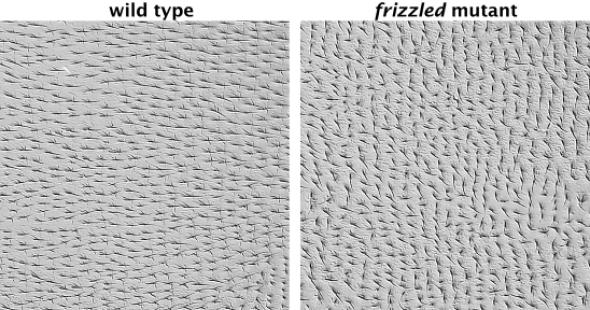
Submitted by Debbie Birkett on Tue, 20/06/2023 - 14:30
Planar cell polarity: intracellular asymmetry and supracellular gradients of Frizzled
To build an animal, cells need information telling them which parts to build, and how to place and orient those parts. One prevailing theory is that tissues make concentration gradients of molecules and individual cells can then determine their orientation by reading the slope of the gradient. Department of Zoology researchers, José Casal, Freya Storer, and Peter Lawrence have now measured the concentration gradient of one these molecules in a living fly, providing evidence for how this orienting information works. The researchers measured the gradients of a protein called Frizzled for the first time in the epidermis of a fly. They found this gradient to be oriented and arranged as predicted years ago. Moreover, Frizzled is distributed asymmetrically in each cell as expected from the slope of the gradient. This research provides new evidence into how cells organise themselves when forming a tissue.
Planar cell polarity, the coordinated orientation of structures such as cilia, mammalian hairs or insect bristles, depends on at least two molecular systems. We have argued that these two systems use similar mechanisms; each depending on a supracellular gradient of concentration that spans a field of cells. In a linked paper we studied the Dachsous/Fat system. We found a graded distribution of Dachsous in vivo in a segment of the pupal epidermis in the abdomen of Drosophila. Here we report a similar study of the key molecule for the Starry Night/Frizzled or “core” system. We measure the distribution of the receptor Frizzled on the cell membranes of all cells of one segment in the living pupal abdomen of Drosophila. We find a supracellular gradient that falls about 17% in concentration from the front to the rear of the segment. We present some evidence that the gradient then resets in the most anterior cells of the next segment back. We find an intracellular asymmetry in all the cells, the posterior membrane of each cell carrying about 22% more Frizzled than the anterior membrane. These direct molecular measurements add to earlier evidence that the two systems of planar cell polarity act independently.
Image above: Hairs in the cuticle of a fly are oriented in a coordinated fashion (Planar Cell Polarity). In frizzled mutants this orientation is severely affected.
Casal J., Storer F., and Lawrence, P.A. (2023) Planar cell polarity: intracellular asymmetry and supracellular gradients of Frizzled. https://doi.org/10.1098/rsob.230105 Open Biology 13: 230105
